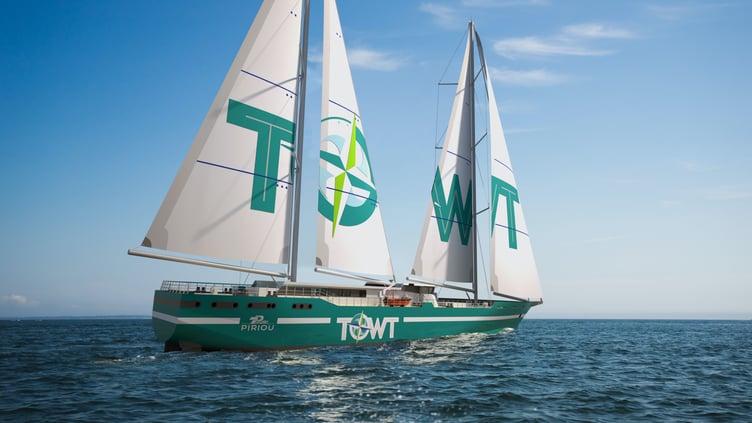In past centuries, wooden cargo ships with multiple masts and enormous sails crossed the oceans. The clippers that brought tea from China took 90 days. Today’s container ships make the same journey in just 30 days, carrying vast amounts of cargo, but at the price of burning fossil fuels and polluting the air.
This summer, a new ship, the Anemos, made the first wind-powered crossing of the Atlantic by a cargo ship in nearly a century, producing less than 5 percent of the emissions of a fossil fuel-powered ship.
Laden with hundreds of pallets of champagne, wine and cognac, she left Le Havre, France for New York. She then sailed on to Colombia to collect a cargo of coffee for the return. Anemos will make the two-week Atlantic crossing eleven times a year, with a cargo of 1,100 tonnes.
Although carrying much less than a container ship, the French company TransOceanic Wind Transport (TOWT), who designed and built the 81-metre sailing cargo ship, aim to demonstrate the viability of wind-powered ships as an alternative to fossil fuel-powered ships. The Anemos, named after the Greek word for ‘wind’, is intended to be the first of an 8-vessel fleet of sailing cargo ships.
The vessel employs sailing technology from ocean racing to reach commercial speeds 90 percent of the time, using AI, satellite communication, meteorological data and routing software to locate and optimise its use of the abundant sea winds.
The ship features two carbon fibre masts, whose lower weight gives greater stability and can hoist significantly larger sails, allowing the ship to capture more wind energy and even sail into the wind. The rigging is fully mechanised, so its crew of seven can furl and hoist the seven sails, totalling 3,000 square metres of cloth sail, all from the wheelhouse using remote control.
Two small diesel-electric engines can be employed in light winds to keep speed and for manoeuvring in port. When wind conditions are favourable, the propellers working in reverse can generate power from the ship’s wake, reducing the need for external sources of energy.
Shipping is a difficult sector to decarbonise with around 5,000 container ships on our oceans emitting a billion tonnes of CO2 a year. However, Norwegian company Yara are pioneering a fully electric and fully autonomous container ship, the Yara Birkeland, with a 7 MWh battery, one thousand times the capacity of a car battery, charged from Norway’s renewable hydropower.
This zero-emission cargo vessel can carry 100 containers at 10 knots, still small compared to the average container ship carrying 24,000 containers at 20 knots! This crewless cargo vessel only operates in Norwegian waters using radar, lidar, AIS tracking, cameras and infrared night vision cameras to navigate, and has slashed operating costs by 90%.
Smaller, cheap to run electric cargo ships that can access smaller ports are already an attractive option. And electric car and passenger ferries are already cost-effective, low maintenance, and improving air quality for passengers, with 70 electric ferries operating in Norway alone.





Comments
This article has no comments yet. Be the first to leave a comment.